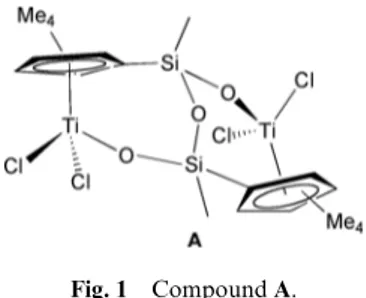Dinuclear dialkoxo bridged cyclopentadienylsiloxo titanium complexes
Texto completo
Figure

![Fig. 2 ORTEP diagrams of [(TiCl) 2 (m-O 2 L)(m- {(h 5 -C 5 Me 4 SiMeO) 2 (m-O) })] (O 2 L = 1,2-O 2 C 2 H 4 1a, 1,2-O 2 C 6 H 4 1b)](https://thumb-us.123doks.com/thumbv2/123dok_es/7289706.348942/4.892.155.736.82.684/fig-ortep-diagrams-ticl-simeo-o-c-h.webp)
![Table 1 Selected bond distances (A ˚ ) and angles ( ◦ ) of compounds 1a ·0.5C 6 H 14 , 1b, 7, [(TiCl 2 ) 2 (m- {(h 5 -C 5 Me 4 SiMeO) 2 (m-O) })] (A), [(TiCl 2 ) 2 (m- {h 5 - -C 5 R 4 SiMe 2 O } 2 )] (R = H B, 32 Me C 39 ) and [(TiMe 2 ) 2 (m-CH 2 )(m-{h 5](https://thumb-us.123doks.com/thumbv2/123dok_es/7289706.348942/5.892.66.826.123.391/table-selected-distances-angles-compounds-ticl-simeo-time.webp)

Documento similar
Hence, although the enol–enethiol tautomers of uracil and its thio derivatives should not be observed in the gas phase, the corresponding Ca 2+ complexes are the most stable
the extrinsic and the intrinsic pathway. The intrinsic pathway integrates signals generated by a variety of stressors, including DNA damage, endoplasmic reticulum stress, loss
The composition of these messenger ribonucleoprotein (mRNP) complexes is dynamic and determines the mRNA fate. Trans-regulatory proteins promoting translation like PAB1 and
Hence, the higher resistance to acidification of the hydride originating from complex 1 results in higher TON and FA concentrations compared to the performance of complexes 2 and
However, in the case of copper, hundreds of complexes based on picolinic acid derivatives have been prepared, giving rise to molecular complexes [20, 21]
Final maps and cross validation of γ(370) 4 and γ(370) 4 ψχ complexes For each complex, two maps resulting from MLF3D refinement of the final image dataset against two
Each trideprotonate 3,5-diacetyl-1,2,4-triazole bis(4-ethylthiosemicar- 16 bazone) ligand acts as a hexadentate in a symmetrical manner bridging two metal ions through the
b Departamento de Química Inorgánica, Universidad Autónoma de Madrid, 28049 Madrid, Spain.. c Departamento de Química Orgánica y Química Inorgánica, Universidad